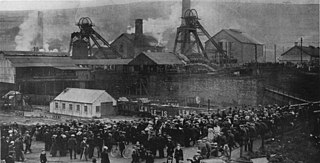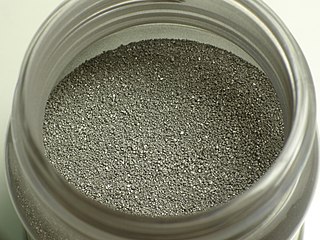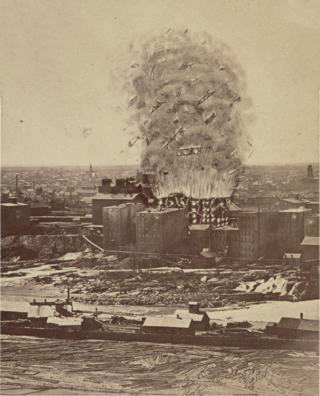
A grain elevator or grain terminal is a facility designed to stockpile or store grain. In the grain trade, the term "grain elevator" also describes a tower containing a bucket elevator or a pneumatic conveyor, which scoops up grain from a lower level and deposits it in a silo or other storage facility.

Sawdust is a by-product or waste product of woodworking operations such as sawing, sanding, milling and routing. It is composed of very small chips of wood. These operations can be performed by woodworking machinery, portable power tools or by use of hand tools. In some manufacturing industries it can be a significant fire hazard and source of occupational dust exposure.

A gas explosion is the ignition of a mixture of air and flammable gas, typically from a gas leak. In household accidents, the principal explosive gases are those used for heating or cooking purposes such as natural gas, methane, propane, butane. In industrial explosions, many other gases, like hydrogen, as well as evaporated (gaseous) gasoline or ethanol play an important role. Industrial gas explosions can be prevented with the use of intrinsic safety barriers to prevent ignition, or use of alternative energy.

Tradeston is a small district in the Scottish city of Glasgow adjacent to the city centre on the south bank of the River Clyde. The name reflected its role as a primarily dockland area with a large number of warehouses and wharves along the riverside were vessels would be unloaded. It merges to the south and west with Kingston, and the two districts are often considered one and the same.
Glasgow was a burgh constituency of the House of Commons of the Parliament of the United Kingdom from 1832 to 1885. It returned two Member of Parliament (MPs) until 1868, and then three from 1868 to 1885. Elections were held using the bloc vote system.

The Senghenydd colliery disaster, also known as the Senghenydd explosion, occurred at the Universal Colliery in Senghenydd, near Caerphilly, Glamorgan, Wales, on 14 October 1913. The explosion, which killed 439 miners and a rescuer, is the worst mining accident in the United Kingdom. Universal Colliery, on the South Wales Coalfield, extracted steam coal, which was much in demand. Some of the region's coal seams contained high quantities of firedamp, a highly explosive gas consisting of methane and hydrogen.

A dust explosion is the rapid combustion of fine particles suspended in the air within an enclosed location. Dust explosions can occur where any dispersed powdered combustible material is present in high-enough concentrations in the atmosphere or other oxidizing gaseous medium, such as pure oxygen. In cases when fuel plays the role of a combustible material, the explosion is known as a fuel-air explosion.
The Cheapside Street whisky bond fire in Glasgow on 28 March 1960 is Britain's worst peacetime fire services disaster. The fire at a whisky bond killed 14 fire service and 5 salvage corps personnel. This fire was overshadowed only by a similar fire in James Watt Street on 19 November 1968, when 22 people died.

Mill City Museum is located in the ruins of the Washburn "A" Mill next to Mill Ruins Park on the banks of the Mississippi River in Minneapolis. The museum, an entity of the Minnesota Historical Society that opened in 2003, focuses on the founding and growth of Minneapolis, especially flour milling and the other industries that used hydropower from Saint Anthony Falls. The mill complex that the museum is within, dates from the 1870s and is listed on the National Register of Historic Places. It is also part of the St. Anthony Falls Historic District and within the Mississippi National River and Recreation Area.

The Great New York City Fire of 1845 broke out on July 19, 1845, in Lower Manhattan, New York City. The fire started in a whale oil and candle manufacturing establishment and quickly spread to other wooden structures. It reached a warehouse on Broad Street where combustible saltpeter was stored and caused a massive explosion that spread the fire even farther.
Events from the year 1872 in Scotland.

A powder is a dry solid composed of many very fine particles that may flow freely when shaken or tilted. Powders are a special sub-class of granular materials, although the terms powder and granular are sometimes used to distinguish separate classes of material. In particular, powders refer to those granular materials that have the finer grain sizes, and that therefore have a greater tendency to form clumps when flowing. Granulars refer to the coarser granular materials that do not tend to form clumps except when wet.

The Rolandmühle in Bremen is an industrial grain mill that is one of the most important private production facilities in the harbour of Bremen. The company has about 100 employees and processes 350,000 tons of grain into flour annually for commercial and industrial use. Both imported and regionally grown grain are processed. The products have been supplied to both regional and export customers.
Fugitive dust is an environmental air quality term for very small particles suspended in the air, primarily mineral dust that is sourced from the soil of Earth's pedosphere. A significant volume of fugitive dust that is visible from a distance is known as a dust cloud, and a large dust cloud driven by a gust front is known as a dust storm.

Paramonov Mill was a grain mill in Rostov-on-Don, Russia. Its ruins currently stand on the corner of Beregovaya Street and 7th of February Lane. The Russian entrepreneur Yelpidifor Paramonov the mill was owned for a time.

The Archer Daniels Midland Wheat Mill was a plant in Chicago's Fulton Market District. The complex included brick loft buildings, a grain elevator, and silos. The oldest buildings in the complex were built in 1897 and were designed by William Carbys Zimmerman and John J. Flanders. It originally served as Eckhart & Swan's wheat and rye mill.

The Great Mill Disaster, also known as the Washburn A Mill explosion, occurred on May 2, 1878, in Minneapolis, Minnesota, United States. The disaster resulted in 18 deaths. The explosion occurred on a Thursday evening when an accumulation of flour dust inside the Washburn A Mill, the largest mill in the world at the time, led to a dust explosion that killed the fourteen workers inside the mill. The resulting fire destroyed several nearby mills and killed a further four millworkers. The destruction seriously impacted the city's productive capacity for flour, which was a major industry in the city. Following the blast, Cadwallader C. Washburn, the mill's owner, had a new mill, designed by William de la Barre, constructed on the site of the old one. This building was also later destroyed, and today the building's ruins are a National Historic Landmark and operated as part of the Mill City Museum.















